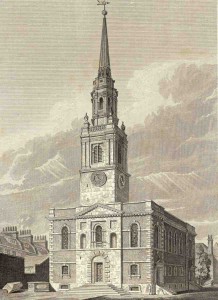A short and intriguing account of body snatching in Clerkenwell, London. It begs some questions: What happened to the perpetrators? Were they arrested? Was there connivance from the church officials?
Bodies, of course, were in great demand by the medical schools (Barts Hospital was a 12-minute walk away). Some infamous suppliers, Burke and Hare in Edinburgh in the late 1820s, and John Bishop, Thomas Williams and James May in London in 1831, took the most pragmatic route and just murdered people for their bodies. The resurrectionists dug them up.
It wasn’t until the Anatomy Act of 1832, which assumed that unless dying patients stated otherwise they consented to dissection, that body-snatching began to decline.1
Before that, some families were so worried about bodies being stolen that they built mortsafes over the graves. Suzie Lennox tweeting as @diggingup1800 has posted some arresting images of mortsafes, including this one at Holystone.
The dainty mortsafe at #Holystone – verdict still out about this one, may just be decorative?
— Suzie Lennox (@DiggingUp1800) March 9, 2015
The Observer, 18 January 1818
An old house in Fox-court, Ray-street, the back part of which looks upon the burying-ground of St. James’s, Clerkenwell, had stood empty for many months, and was fast going to complete ruin; when about five or six weeks ago it was taken by a man who was an entire stranger in the neighbourhood, and who appeared to have no use for it, except for a few hours in the middle of the night, and then strange noises and bustle were often heard. The circumstance excited a good deal of curiosity; but the nature of the business carried on there was never ascertained till yesterday evening, when a little girl who was staying in the chamber of the adjoining house, accidentally discovered a small aperture in the wall, and applying her eye to it, she perceived the dead body of a man stretched out upon the floor & entirely naked. The poor child, in an agony of terror, flew to her parents, and the neighbourhood was instantly in confusion, and the
intelligence carried to the sexton. In consequence, several of the recent away at dusk last night, no less than six coffins had been found empty. It appears that the house was taken by resurrection men for the purpose of storing the bodies for which they could not find sale on the first night of disinterment. There was, however, only one corpse found in it at the time the discovery was made, but there was all the necessary implements of this horrible craft in abundance, such as cords, spades, mattocks, sacks, &c. It was observed that the under sexton or grave-digger was very busily employed at an early hour in the morning in levelling the earth about several of the graves which appear to have been disturbed.2
Ray Street is still in existence, as is St James’s Church.
RELATED POSTS


I believe the 1832 Anatomy Act allowed unclaimed bodies — usually John Does, paupers, prisoners, workhouse inmates — to be given to licensed anatomy practitioners for dissection. The consent, expressed or not, of the deceased was not a factor, only whether they had anyone living to claim them. It’s modern organ donation laws that structure consent as an opt-out, and very effective they are too.
What a rich and fascinating site you’ve created here, Naomi. I plan to devour it all gluttonously.
Thanks for this clarification, Livius, and for your kind words. Naomi
What a great post and thanks for the mention, very much appreciated! I seem to remember a similar story to this (perhaps it’s the same one) – they all tend to roll into one sometimes. I’ll let you know if I ‘dig up’ anything that can provide further information. Thanks for sharing!
Thanks, Suzie. Keep up the good work!